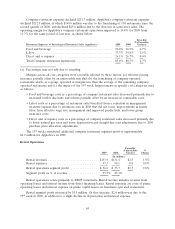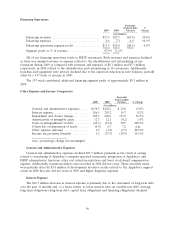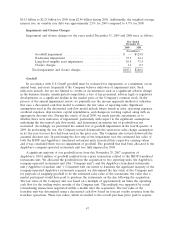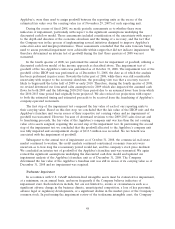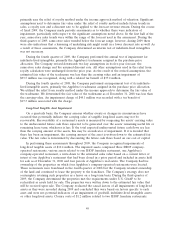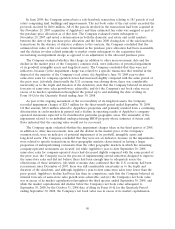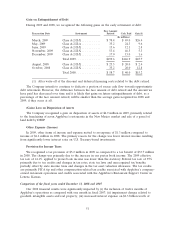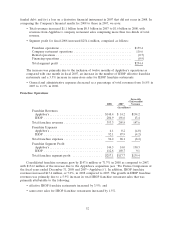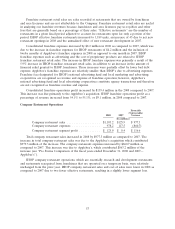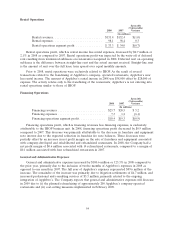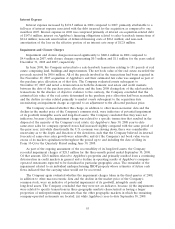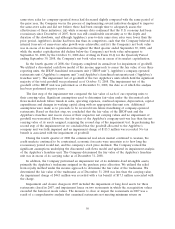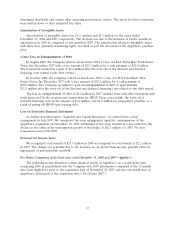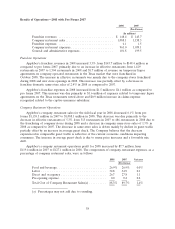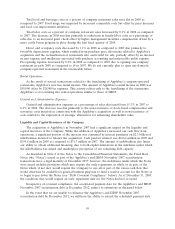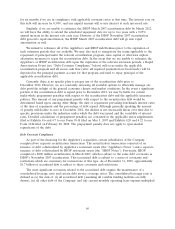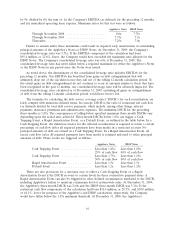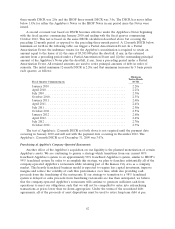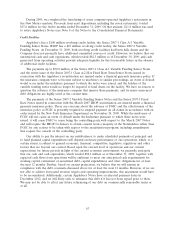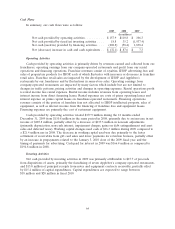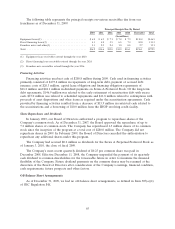IHOP 2009 Annual Report Download - page 74
Download and view the complete annual report
Please find page 74 of the 2009 IHOP annual report below. You can navigate through the pages in the report by either clicking on the pages listed below, or by using the keyword search tool below to find specific information within the annual report.Interest Expense
Interest expense increased by $174.5 million in 2008 compared to 2007, primarily attributable to a
full year of interest expense associated with the debt incurred for the acquisition as compared to one
month in 2007. Interest expense in 2008 was comprised primarily of interest on acquisition-related debt
of $147.6 million; interest on Applebee’s financing obligations related to sales- leaseback transactions of
$14.4 million; non-cash amortization of deferred financing costs of $26.1 million; and non-cash
amortization of the loss on the effective portion of an interest rate swap of $12.8 million.
Impairment and Closure Charges
Impairment and closure charges increased significantly to $240.6 million in 2008 compared to
$4.4 million in 2007, with closure charges representing $0.3 million and $1.1 million for the years ended
December 31, 2008 and 2007, respectively.
In June 2008, the Company entered into a sale-leaseback transaction relating to 181 parcels of real
estate comprising land, buildings and improvements. The net book value of the real estate exceeded the
proceeds received by $40.6 million. All of the parcels involved in the transactions had been acquired in
the November 29, 2007 acquisition of Applebee’s and their estimated fair value was assigned as part of
the purchase price allocation as of that date. The Company evaluated events subsequent to
November 29, 2007 and noted a deterioration in both the domestic real estate and credit markets
between the date of the purchase price allocation and the June 2008 closing date of the sale-leaseback
transactions. In the absence of objective evidence to the contrary, the Company concluded that the
estimated fair value of the real estate determined in the purchase price allocation had been reasonable,
and the decline in value related primarily to market events subsequent to the acquisition date
necessitating an impairment charge as opposed to an adjustment to the allocated purchase price.
The Company evaluated whether this charge, in addition to other macroeconomic data and the
decline in the market price of the Company’s common stock, were indicators of potential impairment
of its goodwill, intangible assets and long-lived assets. The Company concluded that they were not
indicators, because (i) the impairment charge was related to a specific transaction that resulted in the
disposal of the majority of the Company’s real estate; (ii) Applebee’s June 30, 2008 year-to-date
same-store sales for company-operated stores had increased slightly compared with the same period of
the prior year; (iii) while directionally the U.S. economy was slowing down, there was considerable
uncertainty as to the depth and duration of the slowdown, such that the Company believed its internal
forecasts of same-store sales growth were achievable; and (iv) the Company’s net book value was in
excess of its market capitalization throughout the period up to and including the date of filing its
Form 10-Q for the Quarterly Period ending June 30, 2008.
As part of the ongoing assessment of the recoverability of its long-lived assets, the Company
recorded impairment charges of $28.3 million for the three-month period ended September 30, 2008.
Of that amount, $26.8 million related to Applebee’s properties and primarily resulted from a continuing
deterioration in credit markets in general and a decline in operating results of Applebee’s company-
operated restaurants expected to be franchised in particular geographic areas. The remainder of the
impairment related to an individual underperforming IHOP property whose estimates of future cash
flows indicated that the carrying value would not be recovered.
The Company again evaluated whether the impairment charges taken in the third quarter of 2008,
in addition to other macroeconomic data and the decline in the market price of the Company’s
common stock, were an indicator of potential impairment of its goodwill, intangible assets and
long-lived assets. The Company concluded that they were not an indicator, because (i) the impairments
were related to specific transactions in three geographic markets characterized as having a larger
proportion of underperforming restaurants than the other geographic markets in which the remaining
company-operated restaurants are located; (ii) while Applebee’s year-to-date September 30, 2008
55


